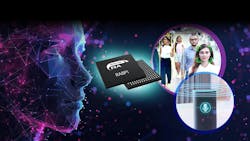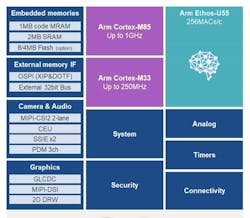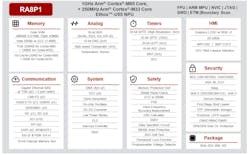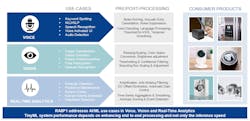MRAM Micro Sports AI Accelerator
What you’ll learn:
- Why MRAM is better for micros than flash memory.
- Why the RA8P1 is a significant advancement for microcontrollers.
- Applications targeted by the RA8P1.
Microcontrollers are available from a plethora of sources, featuring ever-more combinations of peripherals and memory. Occasionally, one comes along that stands out among the crowd. That’s the case for Renesas’ RA8P1 (Fig. 1). This low-power, dual-core microcontroller, which includes the latest 1-GHz Cortex-M85 as well as a 250-MHz Cortex-M33, is built on a 22-nm ULL process node.
Two key features of note are the use of MRAM instead of flash memory and the inclusion of a 500-MHz Arm Ethos-U55 neural processing unit (NPU) (Fig. 2). This artificial-intelligence (AI) accelerator delivers up to 256 GOPS (gigaoperations/s). That translates to 256 MACs/cycle.
Why MRAM is Important for Micros
MRAM has come into its own recently. It’s been around for quite a while but has had limited use in microcontrollers. It was used for data storage because of its low-power operation, byte addressability, and faster write speeds compared to flash memory or other technologies.
Like flash memory, there are numerous MRAM variants, but they tend to share the same features, including low-power writes, fast read/write speeds, and long-term non-volatile storage. MRAM also has lower leakage than flash memory, which becomes more important as silicon production nodes are scaled down.
Part of replacing flash with MRAM involved getting support at major silicon foundries, as many of the micros are from fabless semiconductor companies. Another factor was a matter of scaling, which MRAM actually does better than flash memory as transistors get smaller. An added benefit of its rising popularity is lower cost.
The RA8P1 depends on its 1 MB of MRAM and 2 MB of ECC-supported SRAM for working storage. It supports eXecute-in-Place (XIP) using its octal SPI interface as well as a 32-bit memory interface. For security, off-chip storage can be encrypted and decrypted on the fly. And there’s an option for up to 8 MB of on-chip flash storage.
Why the RA8P1 Combination is an Essential Tool
The RA8P1 can handle a range of AI chores locally. The Ethos-U55 NPU does the heavy lifting, while the Cortex-M85 and Cortex-M33 are optimized with AI-related instructions and data types. The Cortex-M33 can run alone, using significantly lower power requirements. Likewise, the Cortex-M85 is complementary to the NPU, managing some neural-network aspects better than the NPU.
The combination supports commonly used machine-learning (ML) networks like “DS-CNN, ResNet, Mobilenetv1/2/3, Inception, RNNoise, HAR-Github, Wav2Letter, and DeepSpeechet.”
Renesas’ Windows-based e2Studio supports the company’s AI framework that targets its chips, including the RA8P1. This includes pre-trained models for many applications. There’s native tool support for ML frameworks like TensorFlow Lite. They support the Open Neural Network Exchange (ONNX) format as well.
On-chip security is the other part of the puzzle, since these devices are likely linked to the cloud at some point (Fig. 3). This allows the chips to have their own root of trust as well as accelerated security support. Renesas security capability extends to MRAM block protection. Secure debugging is also standard. The first-stage boot loader is contained in ROM.
The microcontroller features the usual complement of peripherals. There’s basic graphics support and analog that includes a multichannel, 16-bit analog-to-digital converter (ADC) and a dual-channel, 12-bit digital-to-analog converter (DAC).
Communication includes a Gigabit Ethernet MAC with time-sensitive networking (TSN) linked to a two-port switch. The switch enables the chip to be part of a deterministic daisy-chain network. CAN-FD, USB, and I2C and I3C are supported as well.
The Renesas Flexible Software Package (FSP) maintains RTOS support for operating systems like Zephyr. This is in addition to the software tools that provide a complete development environment.
RA8P1 Target Applications
The MIPI-CSI2 camera interface plus the NPU supports vision applications such as object detection and image classification that can be used in applications like people counting and face recognition (Fig. 4). Audio inputs can be used for local speech recognition in addition to keyword spotting. Standalone audio and video chores help improve security, privacy, and power requirements compared with connected cloud-based AI solutions.
Of course, the AI capabilities of the RA8P1 can be put to other uses as well, such as predictive maintenance. The real-time support of both processor cores allows for management of motors and other devices that require deterministic control.
The RA8P1 is likely to find homes in spaces like smart cars, sensors for smart cities, and robotics that require audio, video and AI tasks.
About the Author
William G. Wong
Senior Content Director - Electronic Design and Microwaves & RF
I am Editor of Electronic Design focusing on embedded, software, and systems. As Senior Content Director, I also manage Microwaves & RF and I work with a great team of editors to provide engineers, programmers, developers and technical managers with interesting and useful articles and videos on a regular basis. Check out our free newsletters to see the latest content.
You can send press releases for new products for possible coverage on the website. I am also interested in receiving contributed articles for publishing on our website. Use our template and send to me along with a signed release form.
Check out my blog, AltEmbedded on Electronic Design, as well as his latest articles on this site that are listed below.
You can visit my social media via these links:
- AltEmbedded on Electronic Design
- Bill Wong on Facebook
- @AltEmbedded on Twitter
- Bill Wong on LinkedIn
I earned a Bachelor of Electrical Engineering at the Georgia Institute of Technology and a Masters in Computer Science from Rutgers University. I still do a bit of programming using everything from C and C++ to Rust and Ada/SPARK. I do a bit of PHP programming for Drupal websites. I have posted a few Drupal modules.
I still get a hand on software and electronic hardware. Some of this can be found on our Kit Close-Up video series. You can also see me on many of our TechXchange Talk videos. I am interested in a range of projects from robotics to artificial intelligence.





